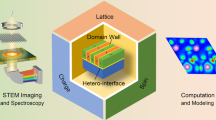Abstract
The ability to manipulate dipole orientation in ferroelectric oxides holds promise as a method to tailor surface reactivity for specific applications. As ferroelectric domains can be patterned at the nanoscale1, domain-specific surface chemistries may provide a method for fabrication of nanoscale devices. Although studies over the past 50 yr have suggested that ferroelectric domain orientation may affect the energetics of adsorption, definitive evidence is still lacking2,3,4,5. Domain-dependent sticking coefficients are observed using temperature-programmed desorption and scanning surface potential microscopy, supported by first-principles calculations of the reaction coordinate. The first unambiguous observations of differences in the energetics of physisorption on ferroelectric domains are presented here for CH3OH and CO2 on BaTiO3 and Pb(Ti0.52Zr0.48)O3 surfaces.
This is a preview of subscription content, access via your institution
Access options
Subscribe to this journal
Receive 12 print issues and online access
$259.00 per year
only $21.58 per issue
Buy this article
- Purchase on Springer Link
- Instant access to full article PDF
Prices may be subject to local taxes which are calculated during checkout




Similar content being viewed by others
References
Scott, J. F. Applications of modern ferroelectrics. Science 315, 954–959 (2007).
Parravano, G. Ferroelectric transitions and heterogenous catalysis. J. Chem. Phys. 20, 342–343 (1952).
Cabrera, A. L. et al. Catalysis of reactions involving oxides of carbon and nitrogen by the ferroelectric compound potassium niobate. Mater. Res. Bull. 14, 1155–1166 (1979).
Cabrera, A. L., Tarrach, G., Lagos, P. & Cabrera, G. B. Influence of crystallographic phase transitions in small ferroelectric particles on carbon dioxide adsorption. Ferroelectrics 281, 53–66 (2002).
Cabrera, A. L., Vargas, F., Zarate, R. A., Cabrera, G. B. & Espinosa-Gangas, J. The size dependent adsorption properties of ferroelectric particles. J. Phys. Chem. Solids 62, 927–932 (2001).
Kalinin, S. V. et al. Ferroelectric lithography of multicomponent nanostructures. Adv. Mater. 16, 795–799 (2004).
Giocondi, J. L. & Rohrer, G. S. Spatially selective photochemical reduction of silver on the surface of ferroelectric barium titanate. Chem. Mater. 13, 241–242 (2001).
Giocondi, J. L. & Rohrer, G. S. Structure sensitivity of photochemical oxidation and reduction reactions on SrTiO3 surfaces. J. Am. Ceram. Soc. 86, 1182–1189 (2003).
Yun, Y., Kampschulte, L., Li, M., Liao, D. & Altman, E. I. Effect of ferroelectric poling on the adsorption of 2-propanol on LiNbO3(0001). J. Phys. Chem. C 111, 13951–13956 (2007).
Henderson, M. A., Otero-Tapia, S. & Castro, M. E. The chemistry of methanol on the surface: the TiO2 (110) influence of vacancies and coadsorbed species. Faraday Discuss. 114, 313–329 (1999).
Kim, K. S. & Barteau, M. A. Reactions of methanol on TiO2(001) single crystal surfaces. Surf. Sci. 223, 13–32 (1989).
Farfan-Arribas, E. & Madix, R. J. Different binding sites for methanol dehydrogenation and deoxygenation on stoichiometric and defective TiO2(110) surfaces. Surf. Sci. 544, 241–260 (2003).
Ferrizz, R. M., Wong, G. S., Egami, T. & Vohs, J. M. Structure sensitivity of the reaction of methanol on ceria. Langmuir 17, 2464–2470 (2001).
Dilara, P. A. & Vohs, J. M. Structure sensitivity in the reaction of methanol on ZrO2 . Surf. Sci. 321, 8–18 (1994).
Lohokare, S. P., Crane, E. L., Dubois, L. H. & Nuzzo, R. G. Collision-induced activation of the beta-hydride elimination reaction of isobutyl iodide dissociatively chemisorbed on Al(111). J. Chem. Phys. 108, 8640–8650 (1998).
Brown, D. E., Moffatt, D. J. & Wolkow, R. A. Isolation of an intrinsic precursor to molecular chemisorption. Science 279, 542–544 (1998).
Carlsson, A. F. & Madix, R. J. Intrinsic and extrinsic precursors to adsorption: Coverage and temperature dependence of Kr adsorption on Pt(111). J. Chem. Phys. 114, 5304–5312 (2001).
Kisliuk, P. The sticking probabilities of gases chemisorbed on the surfaces of solids. J. Phys. Chem. Solids 3, 95–101 (1957).
Bronsted, J. N. Acid and basic catalysis. Chem. Rev. 5, 231–338 (1928).
Evans, M. G. & Polanyi, M. Inertia and driving force of chemical reactions. Trans. Faraday Soc. 34, 11–24 (1938).
Schwartz, R. W. et al. Control of microstructure and orientation in solution-deposited BaTiO3 and SrTiO3 thin films. J. Am. Ceram. Soc. 82, 2359–2367 (1999).
Kalinin, S. V. & Bonnell, D. A. Local potential and polarization screening on ferroelectric surfaces. Phys. Rev. B 63, 125411 (2001).
Kalinin, S. V., Johnson, C. Y. & Bonnell, D. A. Domain polarity and temperature induced potential inversion on the BaTiO3(100) surface. J. Appl. Phys. 91, 3816–3823 (2002).
Acknowledgements
We gratefully acknowledge support of this work by the NSF MRSEC program (grant no. DMR05-20020). A.M.K. and A.M.R. also acknowledge support from the US Air Force Office of Scientific Research (grant no. FA9550-07-1-0397) and the US Department of Energy, Division of Basic Energy Sciences (grant no. DE-FG02-07ER15920) and computational support from the HPCMO of the US DoD.
Author information
Authors and Affiliations
Corresponding author
Rights and permissions
About this article
Cite this article
Li, D., Zhao, M., Garra, J. et al. Direct in situ determination of the polarization dependence of physisorption on ferroelectric surfaces. Nature Mater 7, 473–477 (2008). https://doi.org/10.1038/nmat2198
Received:
Accepted:
Published:
Issue Date:
DOI: https://doi.org/10.1038/nmat2198
This article is cited by
-
Ab initio calculations of CaZrO3 (011) surfaces: systematic trends in polar (011) surface calculations of ABO3 perovskites
Journal of Materials Science (2020)
-
Nanotip-assisted photoreduction of silver nanostructures on chemically patterned ferroelectric crystals for surface enhanced Raman scattering
Scientific Reports (2019)
-
Enhancing oxygen evolution efficiency of multiferroic oxides by spintronic and ferroelectric polarization regulation
Nature Communications (2019)
-
Ferroelectric triggering of carbon monoxide adsorption on lead zirco-titanate (001) surfaces
Scientific Reports (2016)
-
Atomic mechanism of polarization-controlled surface reconstruction in ferroelectric thin films
Nature Communications (2016)



